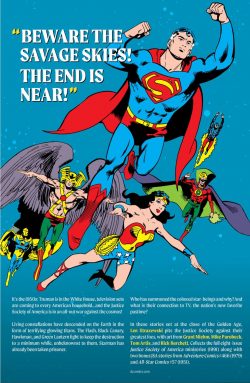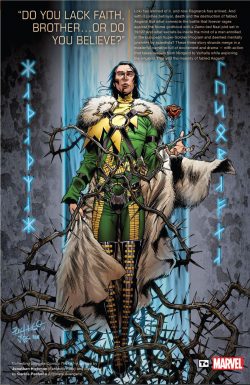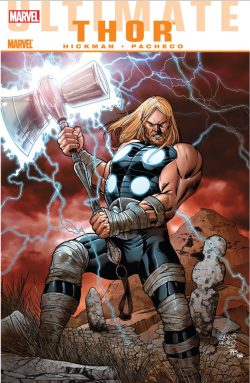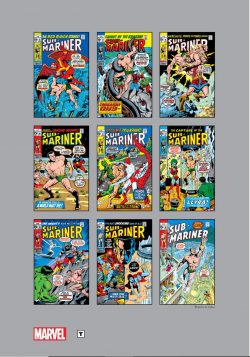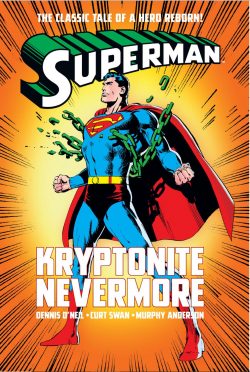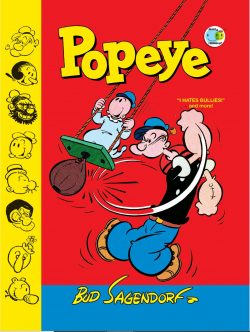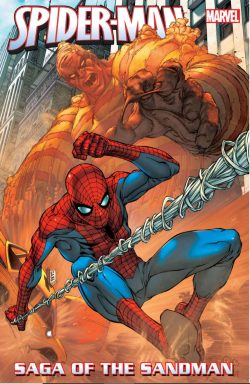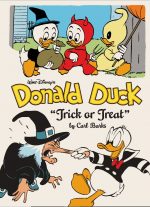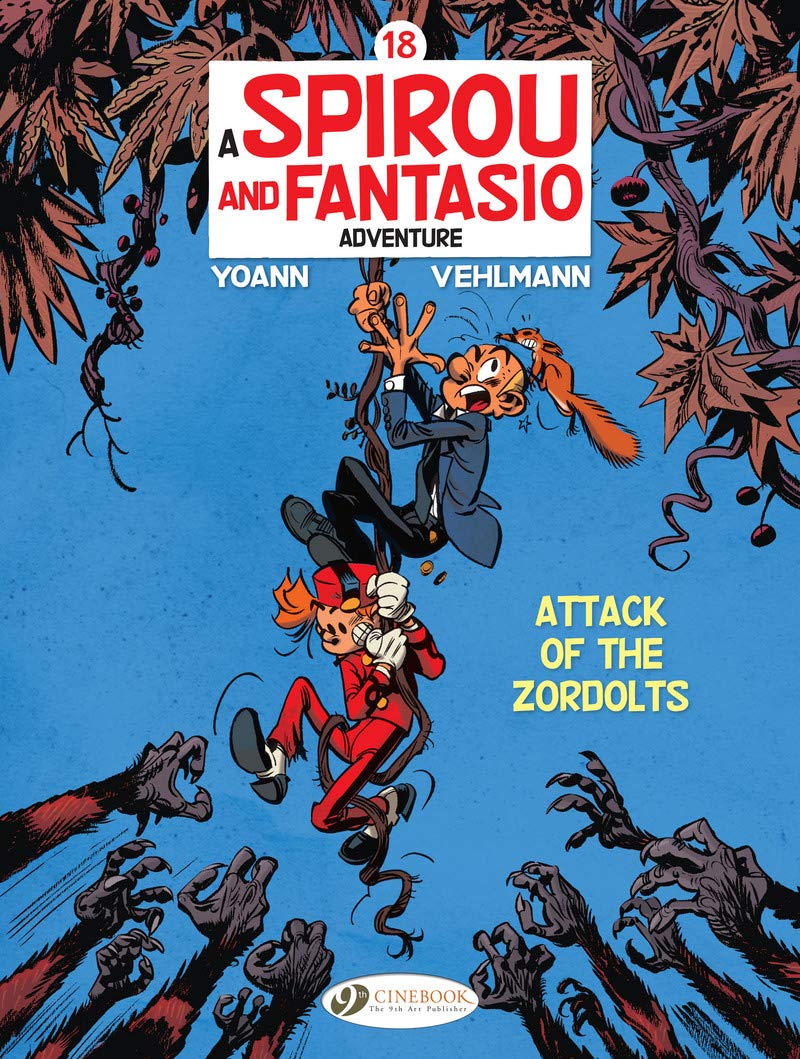
By Yoann & Vehlmann, designed by Fred Blanchard, colored by Hubert & translated by Jerome Saincantin (Cinebook)
ISBN: 978-1-80044-022-7 (Album PB/Digital edition)
Win’s Christmas Gift Recommendation: Manic Mirth and Mad Melodrama… 9/10
Spirou (which translates as both “squirrel” and “mischievous” in the Walloon language) was created by French cartoonist Françoise Robert Velter AKA Rob-Vel for Belgian publisher Éditions Dupuis in response to the phenomenal success of Hergé’s Tintin at rival outfit Casterman.
Soon-to-be legendary weekly comic Le Journal de Spirou launched on April 21st 1938 with a rival red-headed lad as lead feature in an anthology which bears his name to this day. The eponymous hero was a plucky bellboy/lift operator employed in the Moustique Hotel – a sly reference to the publisher’s premier periodical Le Moustique. His improbable adventures with pet squirrel Spip gradually evolved into far-reaching, surreal comedy dramas.
Spirou and his chums have spearheaded the magazine for most of its life, with a phalanx of truly impressive creators carrying on Velter’s work, beginning with his wife Blanche “Davine” Dumoulin who took over the strip when her husband enlisted in 1939. She was assisted by Belgian artist Luc Lafnet until 1943, when Dupuis purchased all rights to the property, after which comic-strip prodigy Joseph Gillain (Jijé) took the helm.
In 1946, his assistant André Franquin assumed the creative reins, gradually ditching the well-seasoned short gag vignettes in favour of epic adventure serials. He also expanded the cast, introducing a broad band of engaging regulars and eventually creating phenomenally popular magic animal Marsupilami.
Franquin was followed by Jean-Claude Fournier who updated the feature over nine stirring adventures tapping into the rebellious, relevant zeitgeist of the times: offering tales of environmental concern, nuclear energy, drug cartels and repressive regimes.
By the 1980s the series seemed outdated and lacked direction. Three different creative teams alternated on the feature, until it was overhauled and revitalised by Philippe Vandevelde (writing as Tome) and artist Jean-Richard Geurts AKA Janry. They adapted, referenced and in many ways returned to the beloved Franquin era.
Their sterling efforts revived the floundering feature’s fortunes, generating 14 wonderful albums between 1984 and1998. As the strip diversified into parallel strands (Spirou’s Childhood/Little Spirou and guest-creator specials A Spirou Story By…), the team on the core feature were succeeded by Jean-David Morvan & José-Luis Munuera. Then Yoann & Vehlmann took over the never-ending procession of amazing adventures…
Multi-award-winning French comics author Fabien Vehlman was born in 1972, began his comics career in 1996 and has been favourably likened to René Goscinny. He’s best known for Green Manor (illustrated by Denis Bodart), Seven Psychopaths with Sean Phillips, Seuls (drawn by Bruno Gazzotti and available in English as Alone), Wondertown with Benoit Feroumont and Isle of 1000,000 Graves with Jason.
He assumed the writing reins on Spirou and Fantasio in collaboration with Yoann. beginning with the book on review here – 2010’s Spirou et Fantasio – Alerte aux Zorkons.
Yoann Chivard was born in October 1971 and was drawing non-stop by the age of five. With qualifications in Plastic Arts and a degree in Communication from the Academy of Fine Arts in Angers, he became a poster and advertising artist whilst dabbling in comics. His creations include Phil Kaos and Dark Boris for British Indie publications Deadline and Inkling, Toto l’Ornithorynque, Nini Rezergoude, La Voleuse de Pere-Fauteuil, Ether Glister and Bob Marone and he has contributed to Trondheim & Sfar’s Donjon. In 2006, Yoann was the first artist to produce a Spirou et Fantasio one shot Special. It was scripted by Vehlmann…
Cinebook have been publishing Spirou & Fantasio’s exploits since 2009, alternating between the various superb reinterpretations of Franquin and earlier efforts from the great man himself. When Jijé handed Franquin all responsibilities for the strip part-way through Spirou et la maison préfabriqué (LJdS #427, June 20th 1946), the new guy ran with it for two decades; enlarging the scope and horizons until it became purely his own. Almost every week fans would meet startling new characters such as staunch comrade and rival Fantasio or crackpot inventor and Merlin of mushroom mechanics Pacôme Hégésippe Adélard Ladislas de Champignac – The Count of Champignac…
Spirou and Fantasio became globe-trotting journalists, travelling to dangerously exotic places, uncovering crimes, exploring the fantastic and clashing with a coterie of exotic arch-enemies such as Fantasio’s deranged and wicked cousin Zantafio and that maddest of scientists, Zorglub.
This old school chum and implacable rival of Champignac is an outrageous Bond movie-flavoured villain who constantly targets the Count. A brilliant engineer, his incredible machines are far less dangerous than his mesmerising mind-controlling “Zorglwave” and an apparently unshakable desire to conquer Earth and dominate the solar system from a base on the Moon…
This tale opens with the seemingly reformed plotter stealing some of Champignac’s most incredible mushroom-based miracles and triggering a massive mutational event in and around the bucolic generally placid hamlet of Champignac-in-the-Sticks.
The first Spirou and Fantasio hear of it is a desperate cell phone call from Pacôme, who has just reappeared after weeks amnesiac and missing. Driving back from a promotional tour, our heroes race across country only to find the placid region is now an armed camp, with soldiers in biohazard gear brutally decontaminating villagers.
The little valley has become a monstrous alien jungle dominated and transformed by weird and incredible plant/animal/fungus creatures, but neither they nor the military – who are keen on immediately nuking the geographical atrocity – can stop our dedicated reporters sneaking in to find their friends.
On locating the Count and his two new chums – hot Swedish science students Astrid and Lena – the lads learn that the brave new world is an accident and hideous side effect of Zorglub’s latest scheme, and that he’s sorrier than anyone at the state of the local environment.
He’s certainly keen enough on fixing the problem…
Other than the fact that everything wants to eat everything else, and that many of the human locals seem comfortable and accustomed to the changes, the main problem seems to be a rapidly proliferating and aggressive form of beast man. The jungle is now a superfast evolutionary Petri dish with everything in it part of an arms race to out-compete all rivals. These brutish bipeds have for some reason evolved immunity to Zorglub’s Zorglwave by having oodles of aggression and not enough intellect. They are ravening, unstoppable Zordolts…
Not sure what’s happening, but resolved to stop the Army bombing the village before foiling Zorglub, everybody works frantically together and succeeds in part one of the plan, but when the jests are repelled and the Zordolts stopped by Champignac’s newly-liberated dinosaur they find the villain vanished.
By the time Champignac has worked his mushroom magic in reverse and restored most of the status quo, the Master of the Z ray is long gone. If our heroes could look up high enough, they might see him well on his way to the moon with Astrid in Lena in tow and about to set his Great Masterwork in motion…
To be Continued…
Rocket-paced, action-packed, compellingly convoluted and with just the right blend of perfectly blending helter-skelter excitement and sheer daftness, Attack of the Zordolts is a terrific romp to delight devotees of easy-going adventure.
Stuffed with an astounding array of astonishing hi-tech spoofery, riotous chases and gazillions of sight gags and verbal ripostes, this exultant escapade is a fabulous fiesta of angst-free action and thrills. Readily accessible to readers of all ages and drawn with beguiling style and seductive energy and wit, this is pure cartoon gold, truly deserving of reaching the widest audience possible.
Buy it for you, get another for the kids and give copies to all your friends…
Original edition © Dupuis, 2010 by Vehlmann, Yoann, Blanchard & Hubert. All rights reserved. English translation 2021 © Cinebook Ltd.


